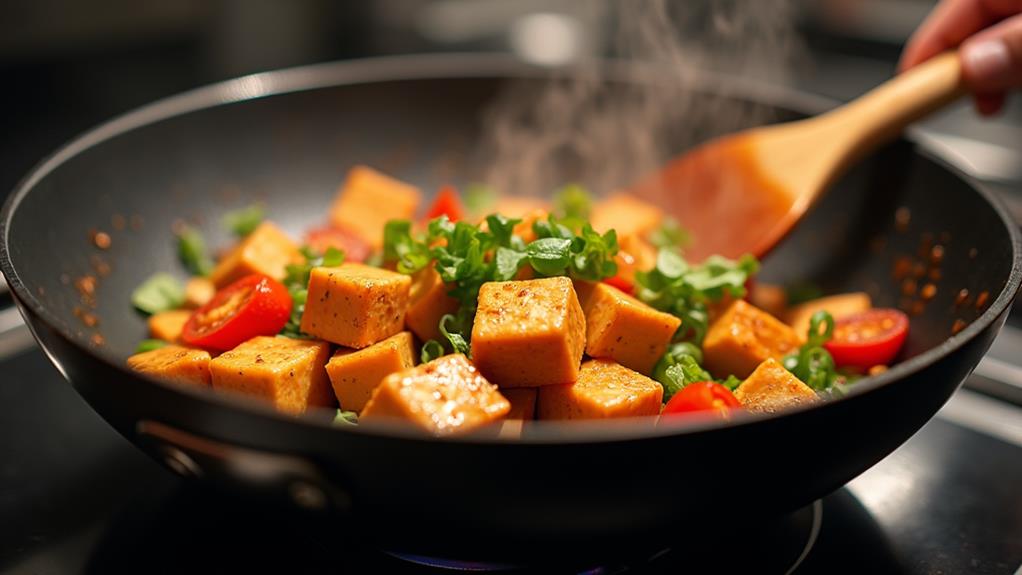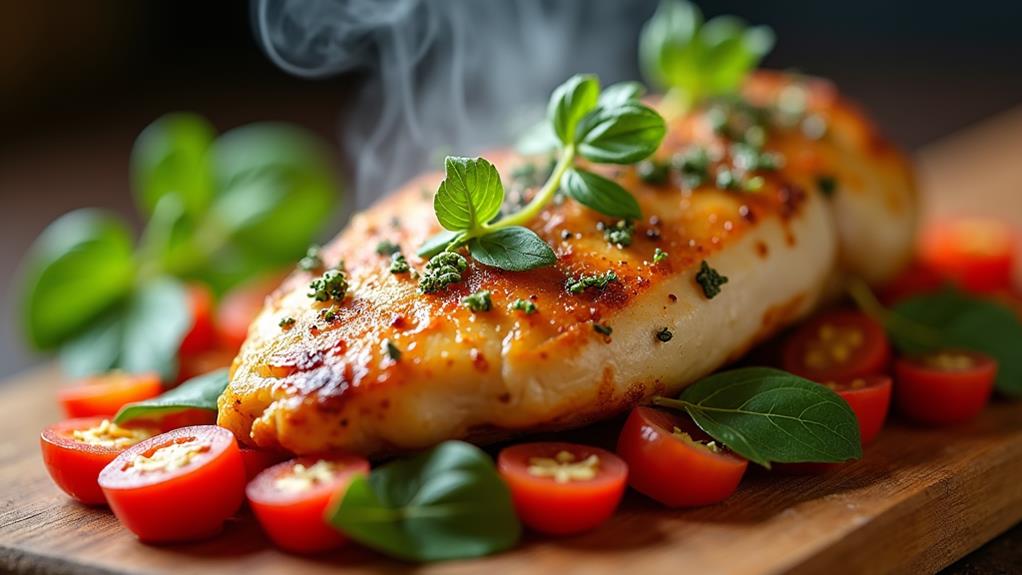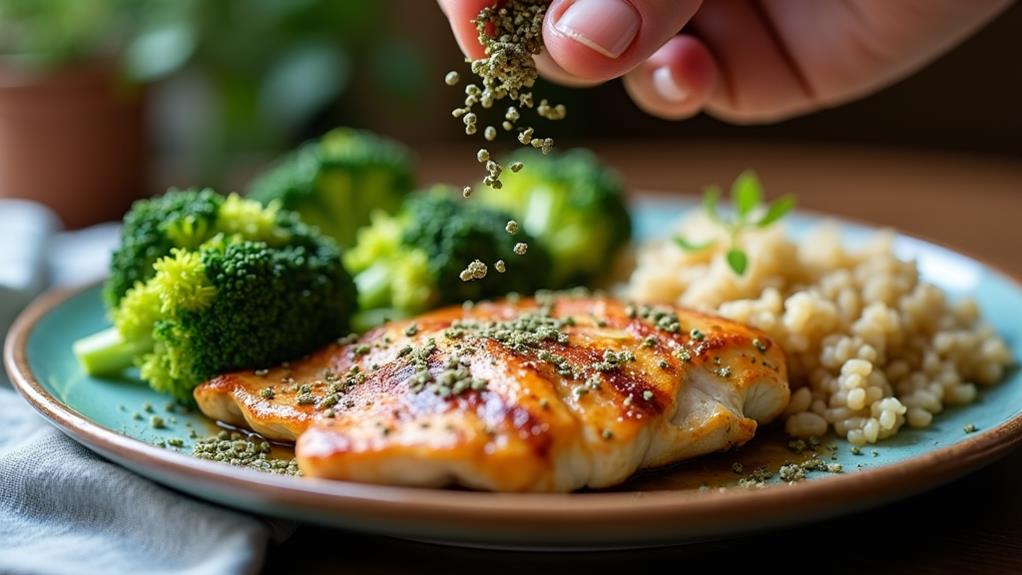To master tofu stir-frying, start by selecting firm tofu and pressing it thoroughly to remove excess moisture. Coat your tofu cubes in cornstarch for a crispy exterior, then pre-fry them for optimal texture. Heat your wok until smoking hot, and use a long-handled spatula to toss ingredients quickly. Build flavor with aromatics like garlic, ginger, and scallions, adding them at the right moments. Incorporate vegetables based on their cooking times, starting with harder varieties. Craft a flavorful sauce using soy or oyster sauce as a base, and balance it with complementary ingredients. Finally, plate your masterpiece with visual appeal. These techniques will elevate your stir-fry game to professional levels.
Choosing the Perfect Tofu
Tofu's versatility in stir-frying hinges on selecting the right type. When you're aiming to elevate your culinary game, understanding the difference between firm vs silken tofu is crucial. Firm tofu, with its dense texture, holds up well during the high-heat stir-frying process, maintaining its shape and absorbing flavors beautifully.
Silken tofu, on the other hand, is best reserved for smoother applications like sauces or desserts.
For optimal results, consider the organic vs conventional debate. Organic tofu often boasts a cleaner flavor profile and fewer additives, allowing the natural soybean taste to shine through in your stir-fry. However, conventional tofu can still yield excellent results if you're working within budget constraints.
When shopping, look for tofu that's firm to the touch but not rubbery. It should have a fresh, mild aroma and be free from any discoloration.
To prepare it for stir-frying, press the tofu between paper towels to remove excess moisture, ensuring a crisp exterior when it hits the hot pan. This step is crucial for achieving that coveted golden-brown sear that'll take your stir-fry to the next level.
Prepping for Ultimate Crispiness
To achieve the ultimate crispy tofu for your stir-fry, you'll need to master a few key preparation techniques.
Start by pressing out excess moisture from your tofu block, which will help it absorb flavors and achieve a firmer texture.
Next, coat your tofu cubes in cornstarch for that coveted crispy exterior, ensuring each piece is evenly covered.
Pressing Out Excess Moisture
Getting your tofu crispy starts with pressing out excess moisture. This crucial step ensures your tofu achieves that perfect golden-brown exterior during stir-frying.
To begin the moisture removal process, wrap your tofu block in clean paper towels or a lint-free kitchen cloth. Place it on a flat surface, like a cutting board or plate, and set a heavy object on top. A cast-iron skillet or a few cookbooks work well for this purpose.
Let the tofu press for at least 30 minutes, though longer is better if you have the time. For those seeking innovative pressing techniques, consider investing in a tofu press. These devices apply even pressure across the entire block, resulting in uniformly pressed tofu.
Alternatively, try the freezer method: freeze your tofu block solid, then thaw and press. This causes the water to expand and create small pockets, allowing for easier moisture extraction.
Whichever method you choose, remember that thorough pressing is key to achieving that coveted crispy texture in your stir-fry. The drier your tofu, the better it will absorb marinades and seasonings, elevating your dish to new heights of flavor and texture.
Cornstarch Coating Technique
After pressing your tofu, it's time to prepare it for the ultimate crispy texture. The cornstarch coating technique is your secret weapon for achieving that coveted crunch. Start by cutting your tofu into uniform pieces, ensuring even cooking.
Interestingly, just like in the preparation of Butternut Squash Mac and Cheese, uniformity in size is key to ensuring that every bite cooks evenly. In a shallow bowl, combine cornstarch with your choice of seasonings, such as garlic powder, paprika, or nutritional yeast, to elevate the flavor profile.
Now, it's time to get hands-on with your coating techniques. Gently toss the tofu cubes in the cornstarch mixture, making sure each piece is evenly coated. For an extra-crispy texture, consider double-coating by dipping the tofu in a plant-based milk before the second cornstarch layer. This method creates a thicker, more substantial crust that'll withstand the high heat of stir-frying.
Once coated, let the tofu rest for a few minutes. This allows the cornstarch to adhere properly, preventing it from falling off during cooking.
Pre-Frying for Texture
The next crucial step in your tofu stir-fry journey is pre-frying for texture. This technique elevates your dish by creating a delightful contrast between the crispy exterior and tender interior of your tofu cubes. To achieve this texture variation, you'll need to master pre-frying methods that transform ordinary tofu into a culinary masterpiece.
Start by heating a generous amount of oil in a wok or large skillet over medium-high heat. Once the oil is shimmering, carefully add your coated tofu pieces in a single layer, ensuring they don't overcrowd the pan. Allow the tofu to fry for 2-3 minutes on each side until golden brown and crispy. You'll notice the exterior developing a satisfying crunch while the inside remains soft and creamy.
For even more innovative results, try double-frying your tofu. After the initial fry, let the pieces cool slightly, then fry them again for an extra crispy exterior. This method creates an incredibly crunchy shell that holds up well in your stir-fry sauce, maintaining its texture even after being tossed with other ingredients.
Mastering High-Heat Wok Cooking
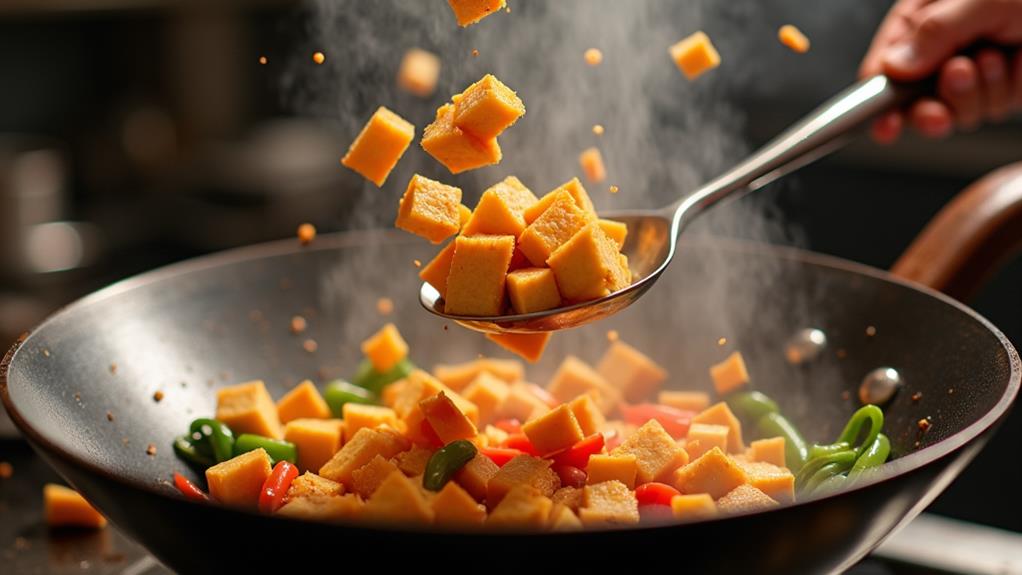
Wielding a wok over high heat is essential for achieving that perfect stir-fry texture and flavor. To master this technique, you'll need to understand the importance of wok temperature and choose the right cooking utensils.
Start by preheating your wok until it's smoking hot, which ensures your tofu and vegetables will sear quickly without becoming soggy. Use a long-handled spatula or wok chuan to toss and stir ingredients rapidly, preventing them from sticking or burning.
As you cook, maintain a consistent high heat by adjusting your burner as needed. This high-temperature cooking method, known as "wok hei," imparts a distinct smoky flavor to your stir-fry.
Keep your ingredients moving constantly, using quick, decisive motions to distribute heat evenly. If you're new to wok cooking, practice your technique with small batches before attempting larger portions.
Remember, timing is crucial; add ingredients in order of their cooking times, with pre-fried tofu going in towards the end to maintain its crispy exterior.
Aromatics: The Flavor Foundation
Aromatics are the cornerstone of flavor in stir-frying tofu, providing a robust foundation for your dish.
You'll need to master the preparation and timing of essential aromatics like garlic, ginger, and scallions to elevate your stir-fry.
Understanding when to add these flavor-packed ingredients will ensure they release their full potential without burning, creating a harmonious balance in your tofu creation.
Essential Aromatics for Stir-Frying
Flavor powerhouses form the backbone of any great stir-fry, and aromatics are key players in this culinary ensemble. To elevate your tofu stir-fry game, you'll want to master the art of using essential aromatics.
These fragrant ingredients not only infuse your dish with depth but also create a symphony of flavors that'll tantalize your taste buds. Incorporating seasonal vegetables into your stir-fry, much like in a Harvest Vegetable Soup, can enhance the freshness and nutritional value of your meal.
Start with the holy trinity of Chinese cooking: garlic, ginger, and scallions. These aromatic herbs provide a solid foundation for your stir-fry's flavor profile. Mince garlic cloves finely, grate fresh ginger, and slice scallions thinly to release their full potential.
For an innovative twist, try incorporating lemongrass or kaffir lime leaves to add a Southeast Asian flair. Don't shy away from experimenting with different combinations to create unique flavor profiles that suit your palate.
Preparing Aromatics Properly
Now that you've identified the key aromatics for your tofu stir-fry, it's time to focus on their proper preparation. To maximize flavor enhancement, start by finely mincing garlic and ginger. This increases their surface area, allowing them to release more flavor and aroma during cooking.
For scallions, separate the white and green parts, slicing the whites thinly and the greens at a slight angle for visual appeal.
When working with dried chili peppers, toast them briefly in a dry pan to intensify their flavor before crushing or grinding. Fresh chilies should be deseeded and finely chopped for consistent heat distribution.
Experiment with aromatic combinations by creating pastes or infused oils. For example, blend ginger, garlic, and lemongrass into a fragrant paste, or infuse oil with star anise and Sichuan peppercorns for a unique twist.
Timing Aromatics' Addition
Timing the addition of aromatics is crucial for building a flavorful foundation in your tofu stir-fry. By mastering aromatic layering techniques, you'll elevate your dish from ordinary to extraordinary. Start by adding garlic and ginger to hot oil, allowing them to release their essential oils and infuse the base. After about 30 seconds, introduce diced onions, letting them soften and become translucent. This sequence creates a complex flavor profile that'll permeate your tofu.
Next, consider the timing nuances of other aromatics. Add hardier herbs like lemongrass or kaffir lime leaves early in the cooking process, giving them time to impart their flavors. Save delicate herbs like cilantro or Thai basil for the final moments, preserving their freshness and aroma.
For an innovative twist, try incorporating dried aromatics like star anise or Sichuan peppercorns at the beginning, then removing them before serving. This technique infuses your stir-fry with subtle, intriguing notes.
The Art of Tossing
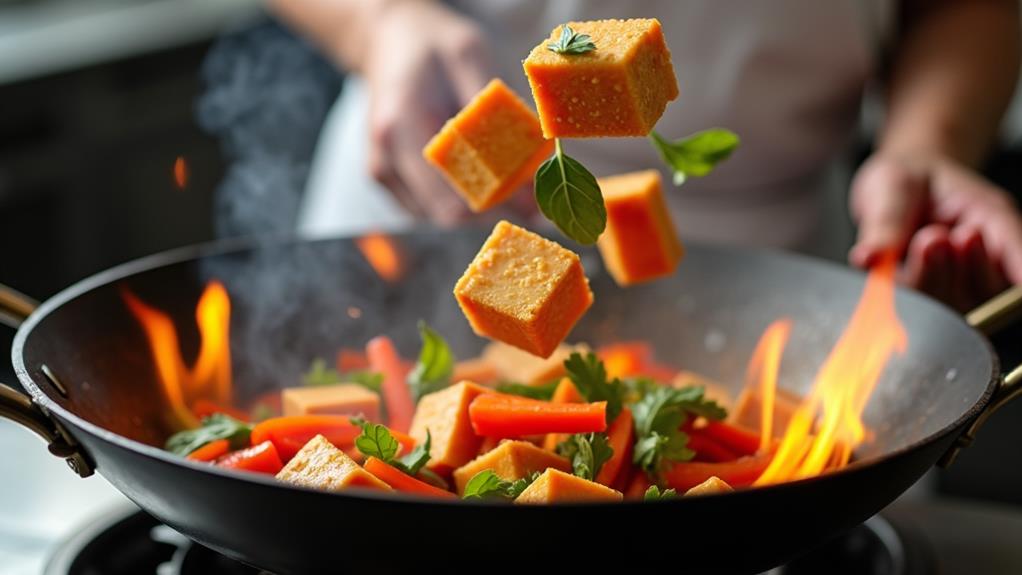
Mastering the art of tossing is crucial for achieving perfectly cooked tofu in your stir-fry. This technique ensures even heat distribution and prevents ingredients from sticking to the pan. To elevate your tossing game, start by practicing with dry ingredients like uncooked rice or beans before moving on to actual food.
When you're ready, grip the wok or pan handle firmly and use a quick, upward motion to flip the ingredients. The key is to maintain control while allowing the food to move freely in the air.
For those seeking innovative tossing techniques, consider investing in specialized tossing tools. A curved spatula or wok chuan can help you maneuver ingredients with precision, especially when working with delicate tofu.
Alternatively, try the two-handed toss method: use one hand to hold the pan and the other to gently shake it, creating a controlled circular motion. This approach works well for larger quantities and reduces the risk of spills.
Vegetable Timing and Textures
As you strive for the perfect tofu stir-fry, understanding vegetable timing and textures is crucial. Different vegetables require varying cooking durations to achieve the ideal texture, and mastering this aspect will elevate your dish to new heights.
Start by categorizing your vegetables based on their density and water content, which directly impact their cooking times. Incorporating elements from roasted root vegetables can also provide inspiration for adding unique flavors and textures to your stir-fry.
Begin with harder vegetables like carrots, broccoli stems, and bell peppers, as they take longer to cook. Add them to the wok first, allowing them to soften slightly before introducing more delicate ingredients.
Next, incorporate medium-textured vegetables such as zucchini, mushrooms, and snap peas. These require less time to cook and will maintain a satisfying crunch.
Finally, add the most tender vegetables like leafy greens and bean sprouts in the last minute of cooking to preserve their freshness and prevent wilting.
Experiment with innovative vegetable combinations to create unique textures and flavors. Try pairing crunchy water chestnuts with silky eggplant, or combine crisp bok choy with tender baby corn.
Sauce Magic
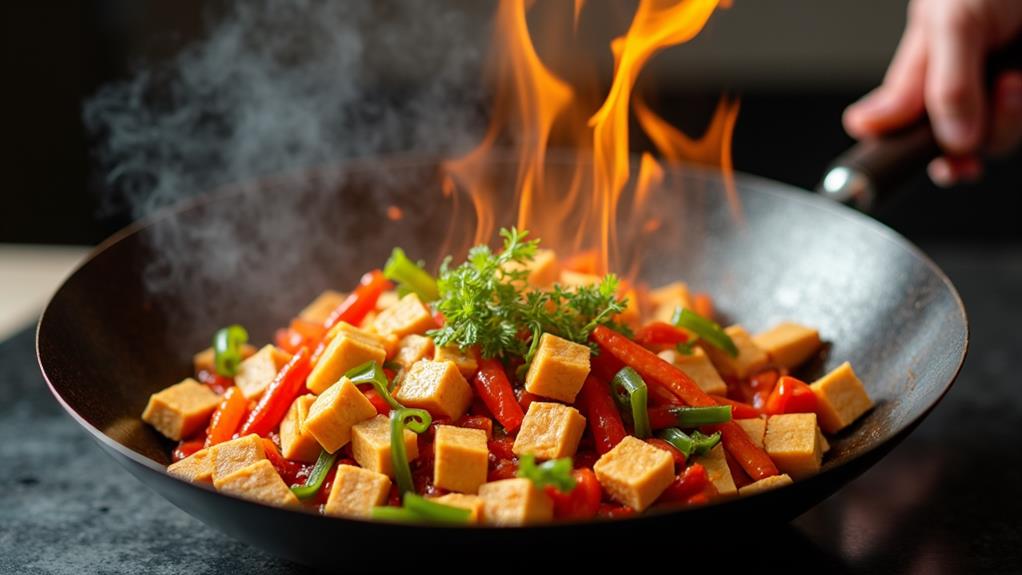
The sauce is the heart and soul of any great tofu stir-fry. It's where you'll infuse your dish with irresistible flavors and create that perfect balance of tastes.
Mastering sauce magic is all about understanding flavor layering and achieving the right sauce balance. Start by choosing a base, like soy sauce or oyster sauce, then build complexity by adding complementary ingredients.
Don't be afraid to experiment with unconventional combinations to create innovative flavor profiles.
When crafting your sauce, consider these elements:
- Umami-rich ingredients like miso or fermented black beans
- Aromatic additions such as ginger, garlic, or lemongrass
- Sweeteners like honey or brown sugar to balance saltiness
Plating Your Stir-Fry Masterpiece
From out of the wok and onto the plate, your tofu stir-fry deserves a stunning presentation. Elevate your dish with innovative plating techniques that'll make your creation Instagram-worthy.
Start by selecting a plate that complements your stir-fry's colors, opting for a neutral backdrop to make your ingredients pop. Arrange the tofu and vegetables in a visually appealing pattern, creating height and dimension by mounding the stir-fry slightly off-center.
Utilize garnish techniques to add flair and enhance flavor profiles. Sprinkle sesame seeds, chopped scallions, or crushed peanuts strategically for texture and visual interest. For a burst of freshness, consider adding a small pile of microgreens or herb leaves.
Don't forget about color contrast; incorporate vibrant elements like thinly sliced red chilies or a wedge of lime to make your dish visually striking. If you've included a sauce, drizzle it artfully around the plate's edges or in a zigzag pattern across the top.
Frequently Asked Questions
Can I Use Frozen Tofu for Stir-Frying?
You can definitely use frozen tofu for stir-frying! It's actually a game-changer. When you freeze tofu, its texture changes, becoming more porous and chewy. This allows it to absorb flavors better and creates a meatier texture.
How Long Does Stir-Fried Tofu Last in the Refrigerator?
Like Cinderella's pumpkin at midnight, your tofu's freshness won't last forever. You've got 3-5 days to savor your stir-fried creation. Maximize tofu storage by refrigerating in an airtight container. Innovate with leftovers before time runs out!
What's the Best Oil Substitute for Stir-Frying Tofu?
You'll love experimenting with oil alternatives for tofu stir-fries! Try coconut oil for a tropical twist, or sesame oil for nutty depth. These options complement various tofu textures while infusing unique flavors into your innovative dish.
Is It Possible to Stir-Fry Tofu Without a Wok?
Did you know 58% of home cooks don't own a wok? You can still stir-fry tofu without one! Experiment with different tofu textures and cooking methods using a large skillet. It's a great opportunity to innovate your culinary techniques.
Can I Marinate Tofu Before Stir-Frying It?
Absolutely! You'll love how tofu marinades enhance flavor absorption. Infuse your tofu with bold tastes before stir-frying. It's a game-changer for creating innovative dishes. Try zesty citrus, savory soy, or spicy ginger marinades for exciting results.
Final Thoughts
You've now unlocked the sizzling secrets of tofu stir-frying, transforming your kitchen into a wok-wielding wonderland. Armed with these techniques, you'll create crispy, flavorful masterpieces that dance on the palate. Remember, practice makes perfect, so don't be afraid to experiment with different textures, sauces, and aromatics. As you continue to refine your skills, you'll find that stir-frying tofu isn't just cooking—it's an art form that brings joy to both chef and diner alike.

